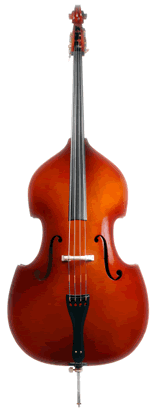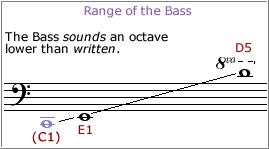|
Bass
Suggested
Range
About Our
Suggested
Ranges
|
 General Information General Information
The primary roll of the basses
is to provide the tonal foundation for the orchestra. This foundation
is often reinforced with the cellos,
playing the bass part one octave
higher. The basses do perform
melodies and counter lines as well. But it is those simple low tones at
the bottom of a rich chord or melody that best define the role of the
basses. Typically, there are eight
basses in the orchestra's bass section. They can perform all the
techniques common to every orchestral stringed instrument, such as ,
and .
For a more complete discussion of these techniques, refer to the Strings-General
chapter.
Tuning
The bass has
four strings - E, A, D and G.

It's interesting to note that
while the other orchestral stringed instruments have strings that are
tuned a apart, the bass strings
are tuned a apart.
Notation
Bass parts are
always written in the Bass
clef. Unlike the other stringed instruments whose parts are written
at concert pitch, the bass part
is notated one octave higher than it sounds.
Range
Traditionally, the lowest written
note for the bass is E1
(an octave plus a
below Middle C). However, many basses
are now equipped with a C extension, making C1
- a below that E1 - the lowest
note (and including all the notes in between). Its highest note varies,
depending upon the player, but a safe top written note would be D5 (an octave plus a Major 2nd above Middle
C).

|
Concert
Pitch
Review

|